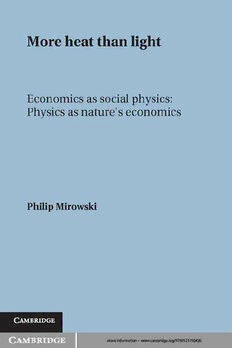
More Heat than Light: Economics as Social Physics, Physics as Nature's Economics PDF
Preview More Heat than Light: Economics as Social Physics, Physics as Nature's Economics
More heat than light Historical Perspectives on Modern Economics General Editor: Professor Craufurd D. Goodwin, Duke University This series contains original works that challenge and en· lighten historians of economics. For the profession as a whole it promotes a better understanding of the origin and content of modern economics. Other books in the series Don Lavoie: Rivalry and central planning: the socialist calculation debate reconsidered Takashi Negishi: Economic theories in a non-Walrasian tradition Roy Weintraub: E. General equilibrium analysis: studies in appraisal William J. Barber: From new era to New Deal: Herbert Hoover, the economists, and American economic policy, 1921-1933 K yun Kim: Equilibrium business cycle theory in historical pers pective Gerard M. Koot: English historical economics, 1870-1926: The rise of economic history and neomercantilism M. June Flanders: Internatwnal monetary economics, 1870-1960: Between the classical and the neoclassical Mary S. Morgan: The history of econometric ideas E. Roy Weintraub, Stabilizing Dynamics: Constructing Economic Knowledge More heat than light Economics as social physics: Physics as nature's economics Philip Mirowski Tufts University CAMBRIDGE UNIVERSITY PRESS cambridge university press Cambridge, New York, Melbourne, Madrid, Cape Town, Singapore, São Paulo, Delhi, Dubai, Tokyo, Mexico City Cambridge University Press The Edinburgh Building, Cambridge CB2 8RU, UK Published in the United States of America by Cambridge University Press, New York www.cambridge.org Information on this title: www.cambridge.org/9780521426893 © Cambridge University Press 1989 This publication is in copyright. Subject to statutory exception and to the provisions of relevant collective licensing agreements, no reproduction of any part may take place without the written permission of Cambridge University Press. First published 1989 First paperback edition 1991 Reprinted 1995, 1999 A catalogue record for this publication is available from the British Library Library of Congress Cataloguing in Publication Data isbn 978-0-521-35042-6 Hardback isbn 978-0-521-42689-3 Paperback Cambridge University Press has no responsibility for the persistence or accuracy of URLs for external or third-party internet websites referred to in this publication, and does not guarantee that any content on such websites is, or will remain, accurate or appropriate. Information regarding prices, travel timetables, and other factual information given in this work is correct at the time of first printing but Cambridge University Press does not guarantee the accuracy of such information thereafter. To the most profound economic philosophers of the 20th century: Thorstein Veblen Nicholas Georgescu-Roegen As late as a week ago, such a phrase as "hopefully awaiting the gradual convergence of the physical sciences and the social sci ences" would have provoked no more than an ironic tingle or two at the back of my neck. Now it howls through the Ponchi toula Swamp, the very sound and soul of despair. -Walker Percy, The Moviegoer Contents Figures page v Acknowledgments Vil 1 The fearful spheres of Pascal and Parmenides 1 2 Everything an economist needs to know about physics but was probably afraid to ask: The history of the energy concept 11 Energy before "energy" 12 Live force and dead force 16 The motive force of fire 23 The Lapla- cian Dream 26 Some mathematics of conservation principles 30 The "discovery" of the conservation of energy 35 What was discovered? 50 The energetics movement 5 3 Entropy: More heat than light 5 9 The awakening from the Laplacian Dream 66 The theory of relativity 77 Quantum mechanics 82 Who's afraid of the nonconservation of energy? 90 3 Body, motion, and value 99 The discovery of energy conservation rechauffe 101 Measurement, mammon, momentum, and man 108 Darwinian evolution as metaphor 117 Lineamentrics from Slevin to Whewell 119 Energy as metaphoric syn- thesis 127 Physics off the gold standard 132 4 Science and substance theories of value in political economy to 1870 139 The metaphor of value 140 Aristotle discovers the economy 144 Two kinds of mercantilism 14 7 Vil viii Contents Physiocracy: More wheat than Zeit 154 Smith and Say: Cartesian crossroads 163 Ricardian vices 171 Karl Marx and the swan song of substance theories of value 174 The watershed 185 Entr'acte 191 5 Neoclassical economic theory: An irresistable field of force meets an immovable object 193 Classical political economy: Paradoxes of motion 197 Precursors without energy: Canard, Bentham, Cournot 202 Hermann Gossen and the transition to neoclassical economics 210 The marginalist revolution of the 1870s 217 The canonical neoclassical model 222 Some consequences of a field theory of value 231 The sciences were never at war? 241 Walras, jevons, Menger 254 Marshall: More discreet than right 262 Neocwssical economics as a species of energetics 265 The syndetic stage? 270 The imperatives of proto-energetics 27 1 6 The corruption of the field metaphor, and the retrogres sion to substance theories of value: Neoclassical produc- tion theory 276 A dyybuk named production 280 Putting square pegs in round holes: Flirting with the conservation of matter 286 Getting more and more out of less and less: The neoclassical production metaphors 293 The spurious symmetry of neoclassical theories of production and consumption 310 The myth of the engineering production function 327 Abandoning the field 332 Every man his own capital theorist 334 Has there been any progress in the theory of value in the 20th century? 350 7 The ironies of physics envy 354 Is economics a science? 356 Rediscovering the field: Integrability and reveakd preference 358 The integrability problem and the misunderstood conservation principles 369 The age of technique 372 Paul Samuelson, scientist 37 8 Why did neoclassical economics cease to seriously emulate modern physical theory? 386 Reprise: The underworld of social physics 394 8 Universal history is the story of different intonations given to a handful of metaphors 396 Contents IX Appendix The mathematics of the Lagrangian and Hamiltonian formalisms 402 Notes 404 Bibliography 414 Index 446
